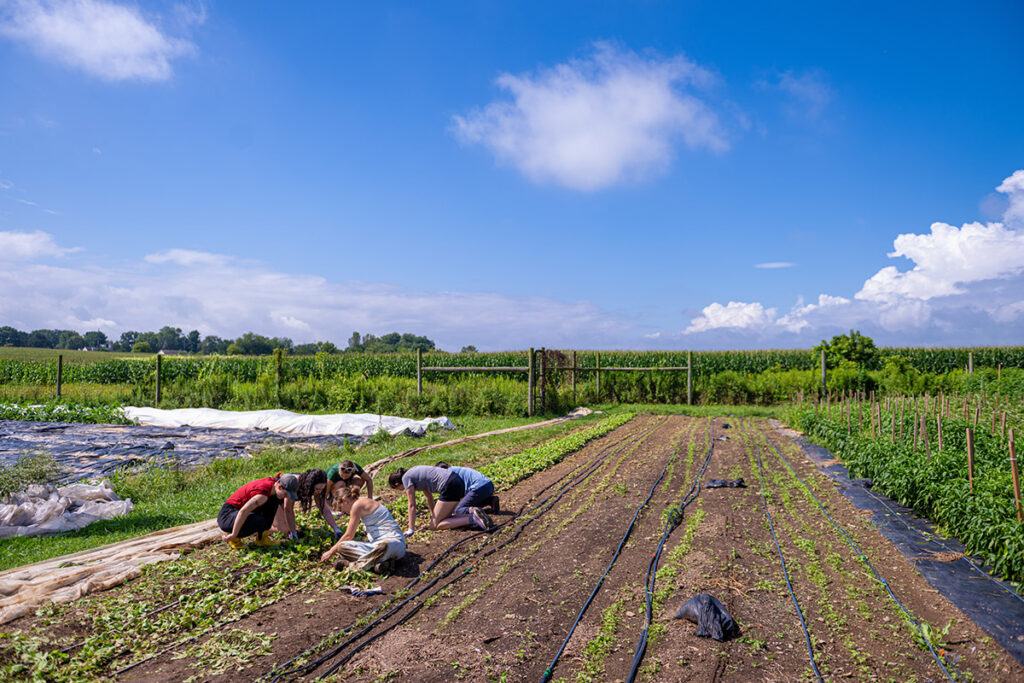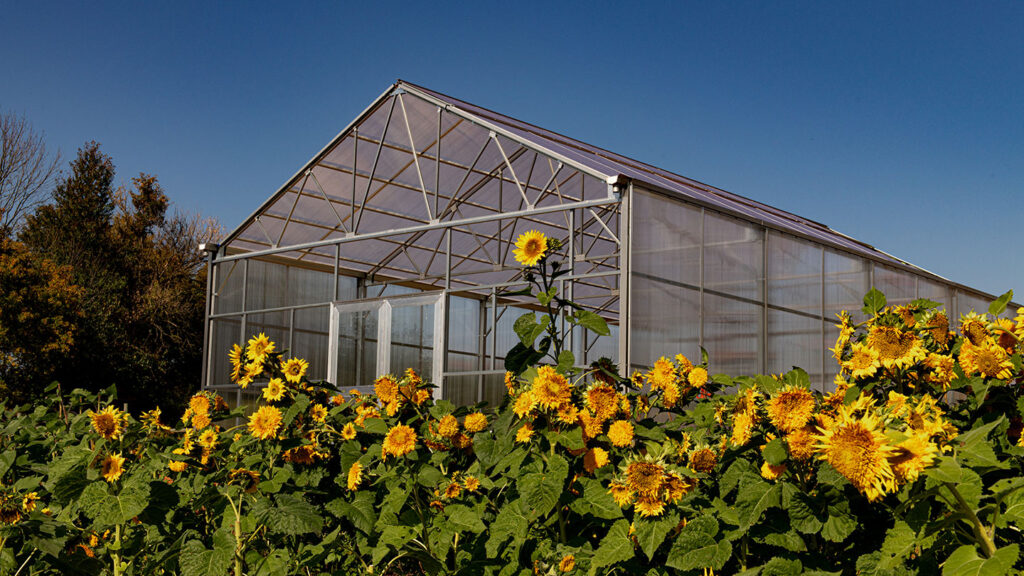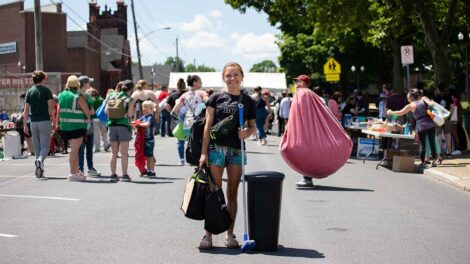Leading the charge in sustainability

Lafayette students tend to produce at LaFarm | Photo by Adam Atkinson
By Stella Katsipoutis-Varkanis
At Lafayette, sustainability isn’t just an ambition: It’s a beating pulse that’s felt throughout campus. The College’s innovative approach to integrating sustainable practices and scholarship into virtually every facet of the campus experience—from classroom learning, to schoolwide operations, to community culture—has distinguished Lafayette among its peer institutions. “It is a unique initiative in higher education, and we do it exceptionally well,” says Delicia Nahman, sustainability director. So well, in fact, that the College earned a gold rating and global recognition for its sustainability programs from the Association for the Advancement of Sustainability in Higher Education (AASHE) last year.
The key to Lafayette remaining on the cutting edge of the field, explains Samantha Smith, sustainability outreach and engagement manager, is boldly taking on new challenges. In 2019, Lafayette became the first college in the Lehigh Valley to set a climate commitment, with a target of achieving carbon neutrality by 2035. “Sustainability is ever-changing,” Smith says. “Our goals are ambitious, and we need to implement innovative solutions in order to reach them.”
With its interdisciplinary spirit, abundant academic resources, and world-class facilities, the Lafayette campus is a living, breathing laboratory where advancements in sustainability aren’t just conceived, but also put into action. And all members of the College community—students, faculty, and staff alike—play a vital role in demonstrating Lafayette’s leadership in the field.

Prof. David Brandes and students survey cross sections of Bushkill Creek. | Photo by Adam Atkinson
Classrooms and labs offer students and faculty boundless opportunities to engage in sustainability-centered research and scholarship: 61% of courses across disciplines incorporate sustainability content. Last year, the College also proposed including a sustainability attribute in the Common Course of Study, a step toward even further integrating the topic into the curriculum—which is another goal of Lafayette’s Climate Action Plan. Additionally, two-thirds of the College’s academic departments conduct sustainability-related research, such as the ongoing study of Easton’s Bushkill Creek and the removal of local dams to restore the critical freshwater mussel population. Study abroad opportunities are also available to students who wish to gain a broader worldview of sustainability issues.
“Students get hands-on experience that truly makes a difference,” Nahman says. “With sustainability woven into their degrees, students are in the best position to graduate with the context, knowledge, and skills to make an impact after graduation, regardless of what profession they end up in.”
Beyond the classroom, Smith says, Lafayette “walks the walk” when it comes to putting sustainable values into practice. LaFarm—the College’s 3-acre working farm and community garden that is the product of student-faculty research on farm systems and food justice—contributes to scholarship and provides access to affordable food to the community. It’s also become a cornerstone of Lafayette’s sustainable food loop.

Sunflowers bloom by the new 30-by-48-foot greenhouse located at LaFarm. | Photo by Adam Atkinson
Thanks to the 18,000 pounds of fruits and vegetables harvested from LaFarm and its new 1,400-square-foot greenhouse, Lafayette’s dining halls and eateries have year-round access to fresh produce to cook up their meals. Any food waste generated from the dining halls then heads to the College’s new composting vessel, which converted more than 35,000 pounds of food into compost just in its first year. The compost, in turn, will be used to enrich the soil at LaFarm. The cycle doesn’t just help reduce carbon emissions, Nahman explains: Students also participate in paid positions as student-interns on the compost crew. “Our sustainable food loop is absolutely unique to the College,” she says. “We have yet to find another college that does this.”
On Oct. 10, the Office of Sustainability will invite local colleges and institutions to tour Lafayette and gain a better understanding of the sustainable food loop process: “Schools from all over the country are interested in learning from us, and we’re excited to learn from them as well,” Nahman adds.
There are also a number of programs in place to bolster the College’s additional commitment of reducing campus waste sent to the landfill by 40% by 2030, and 60% by 2035. All first-year students are provided with a sustainable gift, this year reusable utensils and water bottles, upon their arrival on campus. Students, faculty, and staff can also scan the QR codes on their water bottles anytime they fill up at any one of Lafayette’s 60 water refill stations to participate in the Fill It Forward program, which makes a donation to charity with each scan. Reusable clamshell food containers, smoothie cups, and other containers are also available for Lafayette community members to enjoy goodies on the go in an environmentally friendly way.
Lafayette’s sustainability efforts reach far beyond campus grounds as well: “We’re intentional about centering issues of equity into our sustainability solution creation,” Nahman says. “We leverage our programs to address the immediate and long-term needs and concerns of our community members, and make sustainability accessible.”
Just a few ways the College accomplishes this are the pay-what-you-can models of the campus thrift store and the West Ward Sale, which distribute unused or gently used clothing and other necessities (collected through initiatives like Green Move Out) to students and Easton community members, respectively, at prices they can afford. Last year, 6,500 items were distributed to the local community, West Ward Sale, and campus thrift store with the help of more than 100 volunteers. The thrift store also distributed more than 700 items during move-in this fall.
Leopard leftovers is another initiative that helps “address issues of food insecurity some students are experiencing, while also reducing waste,” Nahman says. The notification system lets students know whenever leftover food is up for grabs following catered campus events.
And because sustainability is a way of life, Lafayette also has a number of programs to help create lasting sustainable habits that campus community members can carry with them throughout their time at the College and beyond. “Our certificate programs are meant to foster behavior change, and create alignment between our sustainability priorities and how we live and work on campus,” Nahman says. These include the Sustainable Office Program for faculty and staff, the Eco Reps Program and Sustainable Living Certificate for students, the Green Labs Program for those engaged in research, and the Sustainable Punch Card Program for students, faculty, and staff who are interested in being rewarded for taking sustainable actions.
With Sustainability Month beginning Oct. 1, Nahman and Smith are looking forward to getting even more campus community members involved in Lafayette’s one-of-a-kind sustainability projects through a series of exciting events. Over the month, the community can participate in one of the 25 programs and events sponsored by 16 campus clubs, departments, and organizations. “This month is a chance for anyone, regardless of major or extracurriculars, to get involved with sustainability in a new way,” Smith says. “It is just the tip of the iceberg when it comes to campus efforts, but showcases all the various ways to join our sustainability journey and highlights the vastness of the community that is innovating each and every day.”

